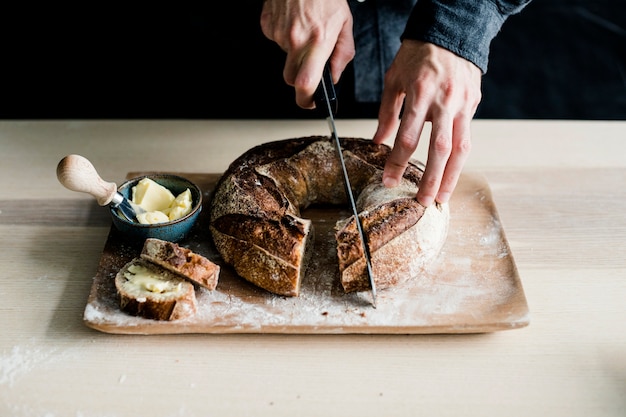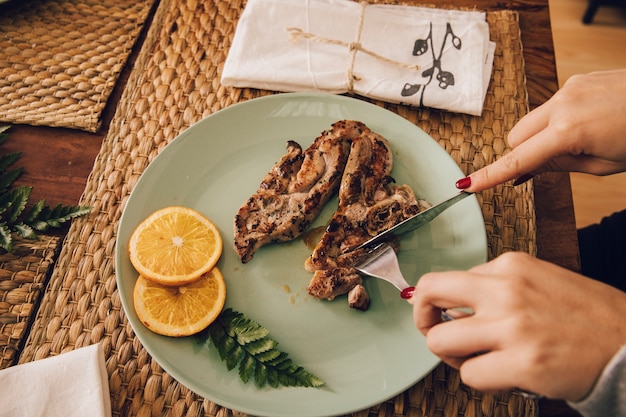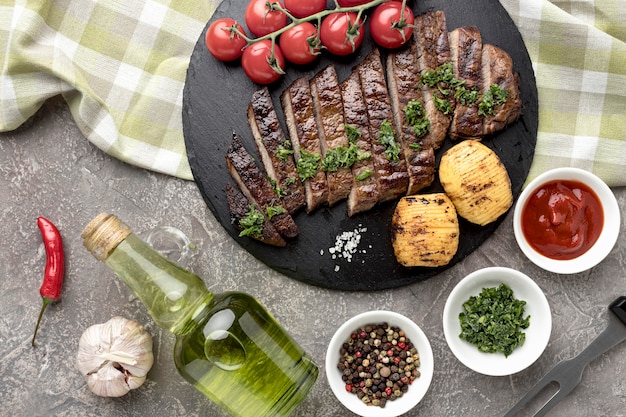Ah, sirloin steak. The mere mention of it conjures up images of sizzling, juicy, perfectly cooked meat. I’ve spent years honing my steak-cooking skills, experimenting with different methods, and learning from both triumphs and disasters. Now, I'm ready to share my knowledge with you. So, grab a notebook, a comfy chair, and maybe a glass of something bold and red – we're about to embark on a culinary journey to steak nirvana!
(Part 1) Choosing the Right Sirloin: Picking a Winner

A. Navigating the World of Sirloin Cuts
Before we dive into the cooking, let's talk about cuts. Sirloin is a wonderfully versatile cut, but there are a few different options to choose from. The classic top sirloin is a leaner cut, known for its firm texture and slightly assertive flavour. It's often a good choice for grilling. Then there’s the bottom sirloin, which is a bit more marbled, offering a richer flavour and a more tender bite. For a real treat, consider strip steak, a boneless, thick-cut sirloin that’s perfect for pan-frying or grilling. And if you want to impress, go for the new york strip, a larger version of the strip steak with a beautiful marbling pattern.
B. Decoding the Grades: Understanding Marbling
You’ll often see terms like “Select,” “Choice,” and “Prime” when browsing the meat counter. These are USDA (United States Department of Agriculture) grades, and they reflect the amount of marbling, those little fat flecks that contribute to flavour and tenderness.
- Select: This is the leanest grade, with minimal marbling, which can lead to a slightly tougher texture.
- Choice: This is the most common grade, striking a nice balance between flavour and tenderness.
- Prime: This is the top tier, boasting the most marbling and resulting in an incredibly rich, juicy, and tender steak. It’s often more expensive, but for true steak enthusiasts, it’s worth every penny.
Think of it this way: The more marbling, the more flavour and tenderness. But don’t worry, even a leaner cut can be cooked to delicious perfection with a little care.
C. Thickness is King: The Key to Even Cooking
When it comes to steak, thickness matters. A thick steak allows for a more even cook, ensuring the centre reaches the desired temperature without the outside burning. Aim for a steak that’s at least 1 inch thick, but 1.5 inches is ideal for achieving that perfect medium-rare.
(Part 2) Preparing Your Sirloin: Setting the Stage for Success

A. The Room Temperature Rule: A Simple Trick for Even Cooking
Ever experienced that frustrating moment where you cook a steak, but the centre seems stubbornly cool even though the outside is done? That’s often because the steak was taken straight from the fridge. The key is to bring your sirloin to room temperature before cooking. This allows for more even heat distribution, ensuring the steak cooks evenly throughout.
Here's what I do: I take the steak out of the fridge about 30-45 minutes before I plan to cook it. I’ll often pat it dry, place it on a plate, and let it sit at room temperature while I prep the other ingredients. It’s a simple step, but it makes a world of difference.
B. Patting it Dry: The Secret to a perfect sear
After your steak has reached room temperature, pat it dry with paper towels. This removes any excess moisture that can interfere with the searing process. A good sear is essential for that crispy, caramelized crust we all crave.
C. Seasoning Your Sirloin: Unleashing the Flavour
Now comes the fun part – seasoning! This is where you can really express your culinary creativity. I’m a classicist, so I usually stick with salt and pepper, but the world is your oyster.
- For a spicy kick: Add a pinch of cayenne pepper, chili powder, or smoked paprika.
- Boosting the umami: Try garlic powder, onion powder, or even a sprinkle of dried herbs like thyme or rosemary.
- A touch of citrus: A squeeze of lemon or lime juice just before cooking can add a refreshing touch.
Season generously, remembering that a little salt goes a long way. Don't be afraid to experiment, but always season evenly on both sides of the steak.
(Part 3) Cooking Methods: Unlocking the Flavor Potential of Sirloin

Now comes the moment of truth. You've chosen the perfect cut, prepped it meticulously, and now it’s time to cook! Here are three of my favourite methods, each offering a unique flavour profile.
A. The Classic Pan-Frying: Simple Yet Spectacular
Pan-frying is a simple and effective method that delivers a delicious, crispy sear. Here's my go-to pan-frying technique:
- Heat a heavy-bottomed pan over medium-high heat. Heavy pans distribute heat evenly, ensuring a consistent cook.
- Add a tablespoon or two of oil. I prefer a neutral oil like canola or grapeseed, which has a high smoke point and won’t impart any unwanted flavours.
- Once the oil shimmers, carefully place the steak in the pan. Don't crowd the pan! Give your steak some space to breathe and sear properly.
- Don’t touch it for at least 3-4 minutes! Patience is key here. Let that beautiful crust develop. You'll hear a delightful sizzle as the steak cooks.
- After 3-4 minutes, flip the steak and cook for another 3-4 minutes on the other side. Again, resist the temptation to touch it too soon.
- If you want a more cooked steak, reduce the heat to medium and continue cooking for a few minutes, flipping every minute or so until your desired doneness is reached.
B. The Grill Master's Delight: A smoky, Charred Experience
For that irresistible smoky, chargrilled flavour, nothing beats a good ol’ grilling session. Here's how to grill a sirloin steak like a pro:
- Preheat your grill to medium-high heat. Ideally, you’ll use a charcoal grill, but a gas grill can also work well.
- Clean the grill grates and lightly oil them with a little bit of olive oil or cooking spray. This prevents the steak from sticking.
- Place your steak on the grill and close the lid. Let the heat work its magic.
- Cook for about 4-5 minutes per side, flipping once. You’ll see beautiful grill marks forming.
- If you want a more well-done steak, continue grilling for another couple of minutes per side.
A tip for grilling: If you’re grilling a thicker steak, consider using a meat thermometer to ensure it's cooked to your liking.
C. The Oven's Gentle Embrace: A Slower, More Controlled Cook
Sometimes, a slower and more controlled cooking method is just what you need. Oven-roasting is a great option for this, especially if you're cooking a larger steak or multiple steaks at once.
- Preheat your oven to 400°F (200°C).
- Place your seasoned steak on a baking sheet. You can line the sheet with parchment paper for easy clean-up.
- Roast for about 10-12 minutes for a medium-rare steak. Adjust the cooking time depending on the thickness of your steak and your desired doneness.
One benefit of oven-roasting is that it’s less likely to dry out your steak, making it a good choice for leaner cuts.
(Part 4) Temperature and Doneness: Mastering the Internal Heat
You know that feeling when you cut into a steak and it’s just not cooked to your liking? We’ve all been there! Let’s avoid those disappointing moments by understanding internal temperatures and what they mean:
| Doneness | Internal Temperature (°F) | Internal Temperature (°C) | Description |
|---|---|---|---|
| Rare | 125-130°F | 52-54°C | Cool red center, very soft texture |
| Medium-Rare | 130-135°F | 54-57°C | Warm red center, juicy and tender |
| Medium | 140-145°F | 60-63°C | Pink center, slightly firmer texture |
| Medium-Well | 150-155°F | 66-68°C | Slightly pink center, firm texture |
| Well-Done | 160°F and above | 71°C and above | No pink, grey center, firm and chewy |
A. The Meat Thermometer: Your Steak-Cooking Ally
No one wants to overcook a perfect steak and end up with a dry, tough piece of meat. That’s where a meat thermometer comes in. This trusty tool allows you to accurately check the internal temperature of your steak and ensure it’s cooked to your desired doneness. It’s a simple, inexpensive investment that can make a big difference in your steak-cooking game.
To use a meat thermometer, insert it into the thickest part of the steak, making sure it’s not touching any bone. Avoid inserting it into the centre of the steak, as this can skew the reading.
(Part 5) The Resting Ritual: Letting the Juices Redistribute
You’ve cooked your sirloin to perfection, but before you dive in, there's one crucial step: resting. Let your steak rest for 5-10 minutes before slicing. During cooking, the juices get pushed towards the outside of the steak. Resting allows these juices to redistribute evenly throughout, resulting in a more juicy and tender piece of meat.
While the steak is resting, you can prepare your accompaniments or simply enjoy a well-deserved glass of wine.
(Part 6) Slicing and Serving: Presenting a steak masterpiece
Finally, it’s time to enjoy the fruits of your labor! I like to slice the steak against the grain. This means slicing across the direction of the muscle fibres. This helps tenderise the steak and makes it easier to chew.
A. The Art of Accompaniments: Pairing Perfection with Your Steak
A perfectly cooked sirloin deserves some equally delicious accompaniments. My go-to’s include:
- Roasted vegetables: The smoky flavour of roasted vegetables complements the rich flavour of sirloin beautifully. Think asparagus, Brussels sprouts, carrots, or sweet potatoes.
- Creamy mashed potatoes: A classic comfort food that provides a creamy counterpoint to the hearty steak.
- Garlic butter sauce: A rich and flavourful sauce that enhances the steak's flavour.
- A simple salad: A refreshing and vibrant salad adds a nice touch of acidity to balance the richness of the steak.
Don’t be afraid to experiment and find combinations that you love!
(Part 7) Mastering Different Donenesses: Visual Cues for Perfect Results
We've talked about doneness and temperatures, but how do you actually know when a steak is cooked to your liking without using a thermometer? Here's a visual guide to different doneness levels, using a simple finger test:
A. Rare
The steak will be cool and red in the center, with a slightly firm texture. To test for rare, press your thumb against your palm and compare the firmness to the steak.
B. Medium-Rare
The steak will be warm and red in the center, with a soft and juicy texture. To test for medium-rare, press your index finger against your palm and compare the firmness to the steak.
C. Medium
The center of the steak will be pink, with a slightly firmer texture. To test for medium, press your middle finger against your palm and compare the firmness to the steak.
D. Medium-Well
The center of the steak will be slightly pink, with a firm texture. To test for medium-well, press your ring finger against your palm and compare the firmness to the steak.
E. Well-Done
The steak will be completely grey throughout, with a firm and chewy texture. To test for well-done, press your little finger against your palm and compare the firmness to the steak.
Keep in mind that this is just a guide, and the best way to ensure your steak is cooked to your liking is to use a meat thermometer.
(Part 8) The Don’ts of Sirloin Steak: Avoiding Common Mistakes
I’ve learned a few things the hard way over the years, so here are some common steak-cooking pitfalls to avoid:
A. Don’t Overcrowd the Pan: Give Your Steak Space
If you’re pan-frying, avoid overcrowding the pan. This will lower the temperature of the pan and prevent a good sear. Give your steak enough space to sizzle and cook properly.
B. Don’t Poke It!: Resist the Urge to Interfere
Resist the temptation to poke the steak while it’s cooking. This can cause it to lose moisture and become tough. Let it cook undisturbed, and it will reward you with a juicy, tender result.
C. Don’t Skip the Resting Time: A Crucial Step for Tenderness
Even if you’re impatient, don’t skip the resting time. This is crucial for a juicy and tender steak. Patience is key to steak perfection!
(Part 9) Storage and Leftovers: Making the Most of Your Steak
You’ve cooked a magnificent sirloin, but what about those leftovers? Here's how to store and use them wisely:
A. Storing Your Steak: Keeping It Fresh for Later
If you have leftover steak, it's best to store it in the fridge in an airtight container or wrap it tightly with plastic wrap. It will last for up to 3-4 days in the fridge.
B. Using Leftovers: Transforming Steak into New Delights
You can enjoy leftover steak in various ways. Slice it and add it to salads, sandwiches, or pasta dishes. You can also dice it up and make a delicious steak hash.
(Part 10) FAQs: Answering Your Steak-Related Questions
Let’s address some common questions about sirloin steak:
A. How do I know if a sirloin steak is fresh?
A fresh sirloin steak should have a bright red color, a firm texture, and a slightly sweet smell. Avoid steaks that have a dull color, a slimy texture, or an off smell. Also, check the packaging date.
B. What’s the best way to season a sirloin steak?
There’s no one right way to season a sirloin steak. It depends on your personal preference. I prefer a simple combination of salt and pepper, but you can add herbs, spices, garlic powder, or onion powder. Experiment and find what you love.
C. How long should I cook a sirloin steak for?
The cooking time for a sirloin steak depends on its thickness and desired doneness. As a general rule, a 1-inch thick steak should be cooked for about 4-5 minutes per side for medium-rare. Use a meat thermometer to ensure your steak is cooked to your liking.
D. How do I prevent a sirloin steak from drying out?
To prevent a sirloin steak from drying out, don't overcook it. Use a meat thermometer to ensure it's cooked to your desired doneness. Also, let the steak rest for 5-10 minutes after cooking before slicing. This allows the juices to redistribute throughout the steak, resulting in a more juicy and tender piece of meat.
E. What are some good side dishes to serve with sirloin steak?
There are many delicious side dishes that pair well with sirloin steak. Some popular choices include roasted vegetables, mashed potatoes, garlic butter sauce, asparagus, Brussels sprouts, and sweet potatoes. You can also pair it with a simple salad or a creamy polenta.
There you have it, my comprehensive guide to mastering the art of sirloin steak. Now go forth and conquer the world of steak, one perfectly cooked piece at a time!
Everyone is watching

Perfect Rice Every Time: The Ultimate Guide to Cooking Rice
Cooking TipsAs a self-proclaimed foodie, I've always been a bit obsessed with rice. It's the foundation of countless cuisi...

Prime Rib Roast Cooking Time Chart: Per Pound Guide
Cooking TipsPrime rib roast. Just the name conjures images of lavish dinners, crackling fires, and hearty laughter. It’s ...

The Ultimate Guide to Cooking Asparagus: Tips, Techniques, and Recipes
Cooking TipsAsparagus. The mere mention of this spring delicacy conjures up images of vibrant green spears, crisp and burs...

Ultimate Guide to Cooking the Perfect Thanksgiving Turkey
Cooking TipsThanksgiving. Just the word conjures up images of overflowing tables laden with delicious food, the scent of r...

How Long to Bake Potatoes in the Oven (Perfect Every Time)
Cooking TipsBaked potatoes are a staple in my kitchen. They're incredibly versatile, delicious, and surprisingly easy to m...
